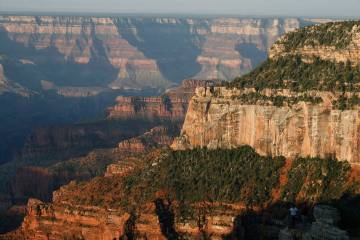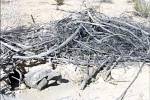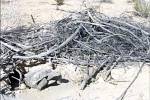Tortoises find a home at Nevada National Security Site
MERCURY - Dressed in full body armor and trained to hide in holes, a cold-blooded team handpicked by the government was set loose Friday inside the Nevada National Security Site.
Its mission: Save the species.
Sixty desert tortoises, each equipped with a radio transmitter and trailing a small antenna, were released at the southern end of the federal installation 60 miles northwest of Las Vegas.
Researchers plan to track the reptiles over the next year as part of ongoing studies ultimately aimed at increasing the threatened animal's numbers in the wild.
"This is their new home," said Jen Germano, a postdoctoral researcher from the San Diego Zoo who is leading the study. "This will be their home for the next 70 or 80 years hopefully."
Friday's release was the first of its kind at the test site, and it came after officials there approached the U.S. Fish and Wildlife Service with the idea of opening up unused land for tortoise research.
The federal installation takes in 1,360 square miles, an area roughly the size of Rhode Island, and not all of it has been blasted by nuclear weapons, bombed by top secret warplanes or exposed to Lord only knows what else.
"To me, it's a perfect partnership, because we've got areas that haven't been touched by human hands or feet," test site spokesman Darwin Morgan said. "If (the research) doesn't get in the way of what we're doing with our other activities, why not?"
The Department of Energy, which operates the Nevada National Security Site, also kicked in $90,000 in tortoise mitigation fees for Germano's study.
About one third of the test site is considered habitat for the federally protected reptile, so the department is required to pay $900 for every acre it disturbs. Morgan said test site officials were looking for a way for that money to "stay on site" so to speak.
Researchers are still trying to get a grasp on how many Mojave Desert tortoises remain in the wild, but the general consensus is that their numbers are on the decline. The primary threats are habitat destruction and disease.
The tortoises released Friday at the southern end of the test site were juveniles - all between 3 and 8 years old with shells roughly 4 to 6 inches long.
There was a mix of males and females, though that sort of thing is tough to tell in tortoises that don't reach sexual maturity until they are 12 to 20 years old.
Some used to be backyard pets. Others were hatched in captivity or were scooped up in places they shouldn't be, namely roads, neighborhoods and construction areas.
Until Friday, all of them lived at the Desert Tortoise Conservation Center, a research and recovery facility the San Diego Zoo operates at the southwestern edge of the Las Vegas Valley under a partnership with the Fish and Wildlife Service and other agencies.
It took Germano and a crew of about a dozen helpers roughly two hours to release the research subjects across a three-mile swath of scrubby desert in what is known as Area 22.
Each tortoise was set free at a carefully selected spot, usually a specific creosote bush plotted in advance with a GPS unit. Each carried a numbered tag and a small radio transmitter glued to its shell with hardware-store epoxy.
Some tortoises barely moved. Others went right to work exploring their new home.
Germano plans to return every day for the first week and once a week after that to find the tortoises again with a radio receiver, note their position and assess their appearance.
Three or four times over the next year, the animals will get a more detailed health exam and, when necessary, a new transmitter with fresh batteries.
Germano said an adult tortoise can cover about two-thirds of a mile in a day, but that's not the biggest challenge when it comes to finding them her newly freed test subjects.
"Tortoises spend 98 percent of their time underground," she said. "If we just put these tortoises out here without trackers on them, it would be impossible to find them again."
Obviously, such field work would be impossible without a suitable place to conduct it.
Roy Averill-Murray is desert tortoise recovery coordinator for the Fish and Wildlife Service in Nevada and California. For years, he said, researchers have successfully released and tracked captive-bred tortoises and former pets in a 44-square-mile area near Jean, but recently they started looking for another swath of protected land to expand their studies.
"It doesn't get much more protected than this," Averill-Murray said.
"This is a huge chunk of protected land," Germano said. "It doesn't have off-road vehicles racing around on it. Nobody's going to build a mall in the middle of the test site."
But working there also comes with some unusual restrictions.
For example, no cameras, including the one on your cellphone, can be used inside the fence without a special permit.
And you must carry a security badge at all times, but you are not to be photographed while wearing it.
Then there is this little tidbit, which was offered up by test site biologist Derek Hall during a briefing just outside the gate Friday morning: Watch out for unexploded ordnance.
"It's really important you don't pick up anything, because you never know what you're picking up," he said.
To which Morgan added, only half-kidding: "The guard will ask if you have any prohibited items. The answer is no."
Germano spent the better part of a year preparing for Friday.
All of the tortoises selected for release underwent numerous health screenings, hours of observation and a battery of tests, including some that border on the bizarre.
Part of Germano's work involves identifying "temperament traits" in tortoises and studying what effect, if any, those traits might have on their success after they are released.
To measure curiosity, for example, researchers recorded the tortoises' responses to things the animals had never seen before, such as brightly colored children's toys.
To gauge boldness, they used a cardboard cutout of a raven to cast a shadow across the tortoise's path and observe its reaction to a threat.
"Some would stay tucked for 20 minutes. Others just flinched and kept going," Germano said.
Her hope is that her work will lead to a better understanding of the desert tortoise and help with efforts to protect it.
But even if no conclusive findings arise from of her release at the test site, one outcome is already guaranteed, Germano said: 60 members of a threatened species have been returned to the wild where they belong.
"It kind of reminds you why got into this work in the first place," she said.
Contact reporter Henry Brean at hbrean@reviewjournal.com or 702-383-0350.




























